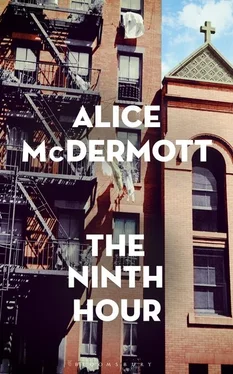THERE WERE the Little Sisters of the Sick Poor, the Little Sisters of the Assumption, the Nursing Sisters of the Sick Poor of the Congregation of the Infant Jesus, the Sisters of the Poor of St. Francis, the Dominican Sisters of the Sick Poor of the Immaculate Conception, the Poor Clares, the Little Company of Mary. There were the Sisters of Divine Compassion, of Divine Providence, of the Sacred Heart. There were the Little Nursing Sisters of the Sick Poor of the Congregation of Mary Before the Cross, Stabat Mater , their own order.
But there were also the Daughters of Wisdom. The Daughters of Charity. The Sisters of Charity. The Benedictine Sisters, the Sisters of St. Joseph, the Sisters of Reparation of the Congregation of Mary. There were the Grey Nuns of the Sacred Heart. The Visitation Nuns. The Presentation Nuns. The Handmaids of the Holy Child. The Sister Servants of the Holy Spirit.
Sister Eugenia admired the Sisters of Mercy. Their foundress—“like our own,” she told Annie, as if courting her native pride—was an Irish woman, a daughter of wealth, called by God to serve the sick poor, first in Dublin, then all over Ireland, England, America. “A wonderful order,” Sister Eugenia said. She named the hospitals they ran, the schools, the very sanatorium upstate where Sister Illuminata had been cured.
Sister Joseph Mary, who kept the convent’s small library, mentioned St. Rose’s Free Home for Incurable Cancer, right across the river and run by the Dominican Sisters of St. Rose of Lima. Their founder was the daughter of Nathaniel Hawthorne, Sister Joseph Mary said proudly. Not a Catholic himself, she explained to Annie, but a great writer nonetheless.
And wasn’t there wonderful work being done for the lepers in Hawaii by the Sisters of St. Francis out of Syracuse? Sister Dymphna kept a scrapbook of inspirational things. Annie was shown a folded newspaper clipping that mentioned Mother Marianne Cope. Most of the article was about Father Damien, the priest to the lepers who had first invited the Sisters to Molokai, but Sister Dymphna had underlined in black ink every good word about the nun. There was a photo of a young girl with leprosy—she had a ruined face, a monstrous face, but she wore a cunning skirt and jacket, as good as you’d see on Fifth Avenue. All Mother Marianne’s doing, the article said. The nun, the article said, had a flair for fashion.
Wouldn’t Annie be proud to see her own child bringing beauty to these suffering souls?
A consensus arose among the Sisters in the convent—perhaps because they had seen the girl helping Sister Illuminata up and down the basement stairs—that Sally would do well with the old folks. The French Little Sisters of the Poor—the order Sister Jeanne herself had once intended to join—did marvelous work in this regard. And the Sisters of Charity had a home for aged domestic workers, immigrants mostly, men and women who had outlived their usefulness and their employers’ largesse—faithful servants of the city’s faithless titans. Wouldn’t Sally be great with them?
Or indigent widows. The Carmelites were mentioned. They had a place on Staten Island.
And then there were the missionary orders to consider: the Foreign Mission Sisters of St. Dominic, the Missionary Sisters of the Immaculate Heart of Mary, of Our Lady of Victory, of the Most Precious Blood. There were the Charity nuns as well, who seemed to be everywhere, doing everything. There were the teaching orders. There were the contemplatives and cloistered, although none of the nuns in the convent believed that such a life would suit Sally—who, they had observed, still fidgeted in the chapel, played with her hair at Sunday mass. Who, even now, despite her call, had to be hushed by her mother when her giddy laughter rose up the basement stairs.
One of the walking orders, then, like their own. An order that would get her out among the poor, out in the air. She might help to care for orphans, childlike as she was. The Sisters of Charity ran the Foundling Home in Manhattan. (“Aren’t they a busy bunch?” Annie asked Mrs. Tierney.) Given her youth and her innocence, her spark of mischief, Sally might, as a Sister, inspire and uplift certain fallen women. The Good Shepherd Sisters had a place for them.
“Give her to the prostitutes,” Annie told Mrs. Tierney. “Send her to China or Africa. Or to Hawaii with the lepers. That’s what they’re proposing. Let her work in an orphanage, they’re saying, after everything I’ve done to keep her out of one.”
When Sally’s high school days were drawing to a close, Sister Lucy ran her yellow eyes over the girl and then told Annie, “Let her follow me for the week. Let her get a glimpse of the work.”
On that early morning in June, mother and daughter entered the convent through the front door rather than the back. They waited for a moment, feeling like visitors in the hushed hallway, until Sister Lucy swung toward them, sweeping down the corridor from the kitchen. She wore her cloak and carried her black satchel. She produced a white postulant’s veil. “Wear this,” Sister Lucy said. “You don’t want to look like a tourist.” And smiled thinly at her own joke. “Come with me,” she said.
Annie helped her daughter fasten the veil and then kissed the smooth top of it as she sent her off. Sally took small, hurried steps, following behind Sister Lucy, as if a long skirt bound her ankles—not her own gait at all. Her mother wondered which of the nuns she was imitating now. She turned. Sister Illuminata was there in the hallway, standing before the basement door, leaning on her cane.
“Baptism by fire,” Sister Illuminata said.
SALLY TOUCHED THE NEW VEIL, once, twice, three times, as she followed behind Sister Lucy. On the avenue she turned her head briefly, trying to capture her own reflection in the various shop windows—watery, she looked, in the morning light. She could barely glimpse her face through the flash of new sun. She’d worn her simplest dress and sensible oxfords from school, but she wanted to see herself with the veil on her head. Wanted to study the transformation. At a corner, she glanced around, hoping to find someone she knew, someone to witness who she had become. “Stop your gaping,” Sister Lucy said as the light changed and she forged on. Sally followed, her head bowed.
At a gray, four-story apartment building, they turned in. The steps were brick, chipped with wear, a pane in the front door was cracked and repaired with brown tape. The door was unlocked. There was a dirty perambulator in the vestibule, its undercarriage full of rust. A knotted plywood board covering its bed. A smell of cats and damp plaster. Sister Lucy climbed the bare stairs, Sally behind her.
The key to the apartment door was on the ring of keys that was tied to the nun’s belt and stored deep in the pocket of her tunic. She fumbled not a bit, finding the right one, opening the door to a spare, neat room: two upholstered chairs, a table, a yellow light through the drawn shades. She spun a bit as she reached to remove her cloak, placed the cloak on one of the chairs, and called out at the same time, “Good morning, Mrs. Costello.”
A small voice from the next room answered, “Good morning, Sister. I’m awake.”
Now the nun was tying the apron she had pulled from her bag around her waist. She rolled up her sleeves as she passed through the living room, Sally following, and into a tiny bedroom—darker still, with drawn shades and drawn drapes—an odor of camphor. The woman was in the bed, stirring. Sally saw in an instant, and with a shudder, the absence under the coverlet, the leg gone below the knee.
“I always know when you’re awake, Mrs. Costello,” Sister Lucy said, correcting her. “I wouldn’t call out if you were still asleep.”
Читать дальше










